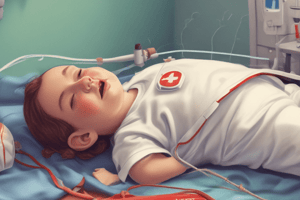Podcast
Questions and Answers
What are the initial steps you should take if a child is drowning?
What are the initial steps you should take if a child is drowning?
Get the child out of the water and perform CPR.
How should a third-degree burn be managed?
How should a third-degree burn be managed?
Do not remove the clothes and take the patient to the hospital.
What is the correct position for a child experiencing convulsions due to a high fever?
What is the correct position for a child experiencing convulsions due to a high fever?
Put the child in an air-conditioned room and apply a damp towel to the forehead.
Which vital signs are important to monitor in a child?
Which vital signs are important to monitor in a child?
How should nose bleeding be managed in a child?
How should nose bleeding be managed in a child?
What precautions should be taken when placing a crib for a child's safety?
What precautions should be taken when placing a crib for a child's safety?
Why is it beneficial to allow toddlers to walk?
Why is it beneficial to allow toddlers to walk?
What steps should you take in the case of a fire to ensure a child's safety?
What steps should you take in the case of a fire to ensure a child's safety?
How often should you move a patient to prevent bed sores?
How often should you move a patient to prevent bed sores?
How can backrubs benefit a patient?
How can backrubs benefit a patient?
Flashcards are hidden until you start studying
Study Notes
Child Emergency Management
- Get the child out of the water in case of drowning and perform CPR
- In case of head injury, control bleeding by applying direct pressure to the wound and call for medical help
Cardiopulmonary Resuscitation (CPR)
- Follow the ABC (Airway, Breathing, Circulation) procedure
- Administer CPR in cases of cardiopulmonary emergency, negative breathing, and pulse
- Use positive pressure and negative breaths for rescue breathing
- Use positive pressure and positive breaths for recovery position
Vital Signs
- Normal vital signs include RR (Respiratory Rate), BP (Blood Pressure), and PR (Pulse Rate)
Bleeding and Wound Management
- Control bleeding by applying direct pressure to the wound
- In case of nose bleeding, instruct the child to lean forward and pinch the nose for 10 minutes
Burns Management
- Treat first-degree burns with cold water
- Treat second-degree burns by washing with cold water and avoiding pricking the blisters
- Treat third-degree burns by not removing clothes and taking the patient to the hospital
Crib Safety
- Lock the crib to prevent accidents
- Raise the siderails of the crib and remove sharp objects
- Place a pillow at the side of the crib and do not place small objects inside
- Place the crib away from windows, doors, and areas where falling debris could be a risk
- Place the crib in the center of the room or near the wall
Toddler Development
- Allowing toddlers to walk promotes mobilization, improves range of motion, and enhances physical/motor growth
Fever Management
- Manage child convulsions due to fever by putting the child in an air-conditioned room, taking the child's temperature, and applying a damp towel to the forehead
Fire Safety
- Vacate the child from the premises in case of a fire
- Use a fire extinguisher to control the fire and call the fire department
Nursing Care
- Provide TLC (Tender Loving Care) when attending to a client's personal needs
- Handle the client gently and give privacy
- Promote blood circulation, prevent pneumonia, and prevent bed sores through backrubs
- Dress a child considering the weather, age, comfortability, and preference
- Orient a patient with low vision to the physical set up, ensure there are no obstacles or sharp objects, and ensure the area is well-lit
- Move patients every 2 hours to prevent complications
Patient Management
- Measure tympanic temperature using an ear thermometer
- Manage a hysterical patient by calming them, listening to them, and helping them recall happy moments
- Manage patients with Alzheimer's by orienting them to the environment and supervising them
- Manage a patient with high blood pressure by providing rest and administering medication
Studying That Suits You
Use AI to generate personalized quizzes and flashcards to suit your learning preferences.




